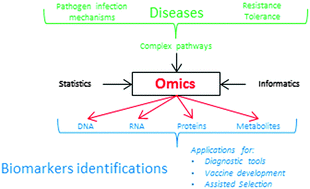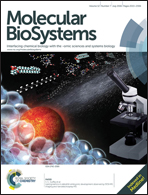Omics approaches to probe markers of disease resistance in animal sciences†
Abstract
Omics technologies have been developed in recent decades and used in different thematics. More advancements were done in human and plant thematics. Omics is the conjugation of different techniques, studying all biological molecules (DNA, RNA, proteins, metabolites, etc.). Omics is then able to study entire pathways, elucidating phenotypes and their control. Thus, thanks to Omics, it is possible to have a broad overview of the linkage between genotypes and phenotypes. Disease phenotypes (tolerance or resistance) are important to understand in both production and health. Nowadays a plethora of research articles are presenting results in the field of natural disease resistance of animals using Omics technologies. Moreover, thanks to advanced high throughput technologies novel modes of infections (infection pathways) are coming to the surface. Such pathways are complex (hundreds to thousands of molecules implied, with complicated control mechanisms), and Omics can generate useful knowledge to understand those pathways. Here we aim to review several angles of Omics used to probe markers of disease resistance with recent publications and data on the field, and present perspectives and its utilization for a better understanding of diseases.

- This article is part of the themed collection: Omics in Animal Sciences


 Please wait while we load your content...
Please wait while we load your content...